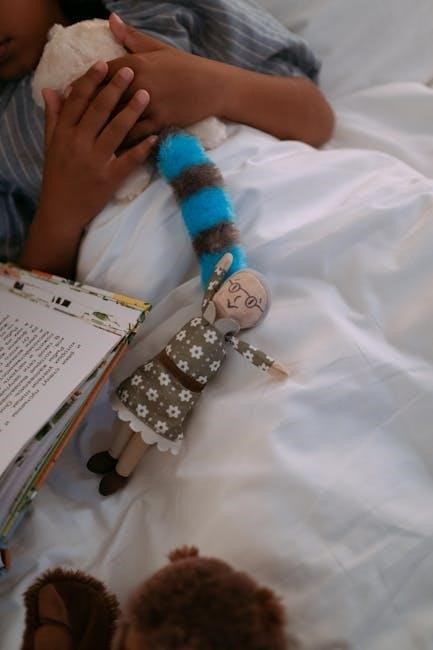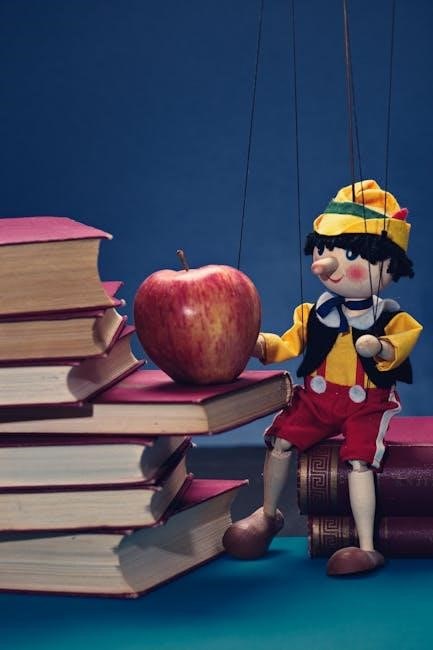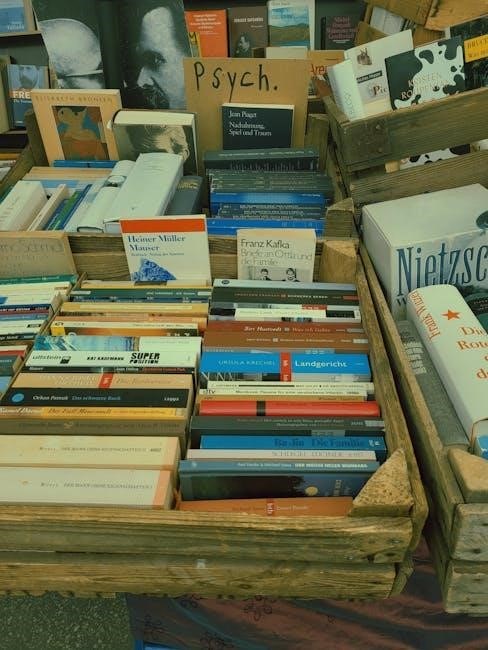Discover the enchanting tale of Franz Kafka and the lost doll, a heartwarming story that showcases his unique storytelling and compassion. This narrative, inspired by real events, follows Kafka as he helps a distraught girl find her beloved doll through a series of imaginative letters, blending fantasy with emotional depth.
Overview of Kafka’s Literary Work

Franz Kafka, a renowned 20th-century writer, is celebrated for his unique, enigmatic prose that explores themes of alienation, existential crisis, and the absurd. His works, such as The Metamorphosis and The Trial, often blur the line between reality and fantasy, creating unsettling yet profound narratives. Kafka’s writing is characterized by its psychological depth, intricate characters, and a haunting sense of inevitability. His stories frequently feature isolated protagonists grappling with incomprehensible circumstances, reflecting his own struggles with identity and societal expectations. The doll story, while lesser-known, aligns with Kafka’s signature style, blending emotional resonance with philosophical inquiry. His literary legacy continues to captivate readers, offering timeless insights into the human condition.
The Unique Narrative of the Doll Story
The doll story uniquely captures Kafka’s storytelling genius through a series of imaginative letters. When a young girl lost her doll, Kafka crafted a narrative where the doll gained a life of its own, embarking on adventures that blended fantasy with emotional depth. This approach, unlike his other works, used epistolary form, with the doll recounting its journey. The tale, while comforting the girl, showcased Kafka’s ability to weave the absurd with the heartfelt, creating a touching yet profound story. This narrative technique stands out in his oeuvre, highlighting his versatility and empathy, making the doll story a cherished anecdote in his literary legacy.

The Background of the Doll Story
Franz Kafka encountered a distraught girl in a Berlin park in 1923 after she lost her cherished doll, inspiring his compassionate and creative response to her sorrow.
Kafka’s Encounter with the Distraught Girl
In 1923, Franz Kafka met a young girl in a Berlin park who was deeply upset over the loss of her cherished doll. Her tears moved Kafka, and he joined her in searching for the missing toy. When their efforts were unsuccessful, Kafka, with his characteristic empathy, offered to help her cope with the loss. He promised to write her letters, imagining the doll’s adventures and travels, creating a comforting narrative to ease her sorrow. This heartfelt gesture not only showcased Kafka’s kindness but also highlighted his ability to transform everyday situations into meaningful stories, reflecting his unique literary genius.
The Search for the Lost Doll
Franz Kafka’s encounter with the distraught girl led to a heartfelt search for her lost doll in Steglitz Park, Berlin. The girl, overwhelmed with grief, had been crying uncontrollably, and Kafka, moved by her distress, joined her in the quest. Despite their combined efforts, the doll remained elusive, leaving the girl inconsolable. Kafka, determined to ease her sorrow, promised to continue the search the next day. This gesture not only highlighted his empathetic nature but also laid the foundation for the imaginative letters he would later write, crafting a narrative to comfort her. The search itself, though unsuccessful, became a poignant moment that showcased Kafka’s ability to connect deeply with others through his words and actions.

Kafka’s Letters to the Girl
Kafka wrote a series of heartfelt letters to the girl, narrating the doll’s adventures and eventual return, blending fantasy with emotional comfort, deeply touching her heart.
The Doll’s “Life” and Adventures
Kafka’s letters crafted a vivid narrative where the doll gained its own identity, recounting its travels and encounters. The doll, though loving the child, sought new experiences, reflecting themes of wanderlust and curiosity. Through its journeys, the doll encountered various characters, gaining wisdom and occasional malice. These tales not only entertained the girl but also offered solace, transforming her sorrow into wonder. The doll’s adventures, as described by Kafka, became a metaphor for life’s unpredictable nature and the resilience of hope, ultimately leading to its return, symbolizing renewal and the enduring bond between the girl and her cherished companion.

Psychological Depth in the Letters

Kafka’s letters to the girl revealed profound emotional complexity, transcending a simple story. He crafted the doll’s narrative to mirror the girl’s inner turmoil, offering solace through imaginative empathy. The letters explored themes of loss, hope, and resilience, reflecting Kafka’s own struggles with isolation and longing. By personifying the doll, Kafka created a metaphor for the human experience, where even inanimate objects hold deep emotional significance. His words not only comforted the girl but also revealed his understanding of the psychological impact of loss, transforming a simple tale into a deeply moving exploration of the human condition. This emotional depth showcased Kafka’s unique ability to weave psychological insight into his storytelling.

Themes and Symbolism in the Story
The story explores themes of loss, hope, and resilience, with the doll symbolizing emotional attachment and the human need for comfort. Kafka’s narrative delves into psychological depth, using the doll as a metaphor for longing and connection, highlighting the transformative power of storytelling and empathy.
The Theme of Loss and Longing
The story of Franz Kafka and the lost doll profoundly explores the themes of loss and longing, resonating deeply with readers. The girl’s distress over her missing doll symbolizes the universal human experience of losing something cherished. Kafka’s compassionate response transforms her grief into a narrative of hope and imagination. Through his letters, he crafts a tale where the doll gains its own identity, symbolizing the enduring power of emotional connections. The doll’s “adventures” serve as a metaphor for the human capacity to cope with loss by creating meaning and continuity. This theme reflects Kafka’s own life, marked by personal struggles and a profound understanding of human vulnerability. The story becomes a poignant reflection on how storytelling can alleviate sorrow and bridge the gap between imagination and reality.
The Symbolism of the Doll
The doll in Kafka’s story serves as a poignant symbol, representing both the girl’s cherished companion and the fragility of attachment. Kafka’s letters breathe life into the doll, transforming it into a character with its own identity and adventures. This narrative device symbolizes the resilience of imagination and the enduring power of emotional bonds. The doll’s journey mirrors human experiences of loss and the quest for meaning, offering a metaphor for the universal struggle to hold onto what is precious. Through the doll, Kafka explores the interplay between reality and fantasy, illustrating how storytelling can transcend sorrow and create profound connections. The doll becomes a timeless emblem of hope and the transformative power of creativity.

Cultural and Literary Impact
Kafka’s doll story has inspired numerous adaptations, including films and stage plays, showcasing its timeless appeal; Its emotional depth and imaginative storytelling continue to resonate globally, celebrating Kafka’s unique legacy.
Reception of the Story in Kafka’s Biography
The story of Kafka and the lost doll has become a cherished anecdote in his biography, highlighting his compassionate and imaginative nature. It first gained attention through accounts by Dora Diamant, Kafka’s close companion, who shared details of his heartfelt gesture. The narrative resonated deeply, offering a rare glimpse into Kafka’s ability to connect with others through storytelling. Biographers like Ronald Hayman and Reiner Stach have included this tale in their works, underscoring its significance in understanding Kafka’s humanity. The story’s emotional depth and imaginative approach have been celebrated, further cementing its place in Kafka’s literary legacy.
Adaptations and Interpretations
The story of Kafka and the doll has inspired various adaptations and interpretations, enriching its cultural significance. It has been translated and included in literary biographies, such as Ronald Hayman’s and Reiner Stach’s works, offering deeper insights into Kafka’s character. Anthony Rudolf’s French translation further broadened its reach. Literary analysts view the narrative as a reflection of Kafka’s compassionate side, contrasting with his typically complex themes. Culturally, it highlights Kafka’s ability to connect emotionally, showcasing a simpler, heartfelt aspect of his writing. These adaptations and interpretations underscore the tale’s enduring appeal and its unique place within Kafka’s legacy, illustrating how his storytelling transcends traditional literary boundaries.
Franz Kafka’s doll story remains a poignant testament to his kindness and creativity. It blends imagination with emotional depth, leaving a lasting impact on his legacy.

The Enduring Legacy of Kafka’s Doll Story
Franz Kafka’s doll story has left an indelible mark on literary history, showcasing his compassion and creativity. This tale, born from a heartfelt encounter, highlights Kafka’s ability to transform a simple gesture into a profound narrative. The story’s emotional depth and imaginative letters have resonated with readers, offering a unique glimpse into Kafka’s humanity. Over the years, it has been shared in biographies, adaptations, and literary discussions, ensuring its place in cultural memory. The doll story not only reflects Kafka’s kindness but also underscores his unique storytelling genius, making it a cherished part of his enduring legacy.